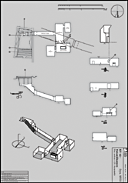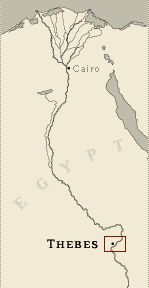|
KV 62 (Tutankhamen)
General Site Information
Structure: KV 62
Location: Valley of the Kings, East Valley, Thebes West Bank, Thebes
Owner: Tutankhamen
Other designations:
Site type: Tomb
Description
KV 62, located in the main wadi, is the
most famous tomb in the world because of the treasures it held
intact for over three thousand years. The entryway A is cut into the
floor of the valley below the beginning of the entry ramp of KV 9,
the tomb of Rameses VI. Even before the construction of KV 9, debris
had already been dumped on top of the KV 62 entrance. The tomb was
forgotten and a group of Rameside workmen's huts were built over it
later in antiquity. A descending corridor (B) leads to a rectangular
chamber (I) with a side chamber (Ia). The burial chamber J opens off
the right (north) end of chamber I with its floor level one meter
lower. Another side chamber (Ja), is located off the right (east)
wall of the burial chamber J. Howard Carter believed that the four
chambers of KV 62, although small, relate directly to lower parts of
more traditional royal tomb plans. The walls of the tomb were
smoother but, except for burial chamber J, were left undecorated.
The burial chamber J is decorated with scenes from the Opening of
the Mouth ritual, Imydwat, Book of the Dead, and representations of
the king with various deities.
Some have theorized that when Tutankhamen died suddenly at an early
age, a tomb that was originally planned for him in the West Valley
(KV 23 or KV 25) was not ready. It may have been decided to bury
Tutankhamen in the main Valley in a tomb originally intended for Ay
when he was still a God's father, near the Amarna cache (KV 55).
According to this theory, Ay later took the West Valley tomb (KV 23)
after succeeding Tutankhamen to the throne.
Noteworthy features
This tomb originally designed for a
non-royal personage nevertheless was used for royal burial, and
possessed a nearly intact set of burial equipment.
Site History
KV 62 may have been constructed for an important official or member
of the royal family, probably in the latter half of Dynasty 18. When
it was taken over for the burial of Tutankhamen, still unfinished, a
burial chamber with side chamber was cut into the right (north) end
of the first chamber. KV 62 was robbed at least twice in antiquity,
judging from three different sets of seals on the doorways
signifying three different closures of the tomb. Other evidence of
theft, besides the disturbed appearance of the objects in chamber I
and side chamber Ia, includes inventory dockets on various
containers that list artifacts not found when the tomb was
discovered. The looters appear to have penetrated past chamber I
into side chamber Ia, chamber J and side chamber Ja, but did not
breach the sealed doors of the shrines surrounding the sarcophagus.
After the final restoration of the burial, perhaps under Horemheb,
the location of the tomb was lost as the debris from subsequent tomb
construction filled the floor of the center of the Valley.
Dating
This site was used during the following period(s):
New Kingdom, Dynasty 18, Tutankhamen
History of
Exploration
Carter, Howard (1922): Discovery (made for the Earl of Carnarvon)
Burton, Harry (1923): Photography (of objects for the Metropolitan
Museum of Art)
Carter, Howard (1923-1932): Excavation (conducted for Earl of
Carnarvon)
Conservation
- Conservation history: Following the 1994 floods, a
new shelter was constructed over and around the entrance to protect
it from water. Metal doors at the top and bottom of corridor B and a
metal stairway have been installed.
- Site condition: Since KV 62 was sealed throughout
its history, flood debris did not fill the tomb. A fault line runs
through the tomb, but it has remained stable and there has been no
structural damage to the chambers.
Carter and his team broke through the partition wall between chamber
I and burial chamber J to remove Tutankhamen's funeral shrine and
other large objects, partially destroying the scenes on the south
(front) wall.
Soot on the burial chamber ceiling reminds us that ancient people
painted by torchlight and oil lamps. A pink stain and black fungus
spots have spread over decorated walls due to moisture. Small
amounts of moisture came from the ancient offerings placed in the
tomb such as vegetation, and also from the gypsum plaster on which
the decoration was painted, which may not have been fully dry when
the tomb was sealed.
|

Printable Tomb Drawings
Axis in degrees: 271.68
Axis orientation: West
Site Location
Latitude: 25.44 N
Longitude: 32.36 E
Elevation: 170.55 msl
North: 99,572.277
East: 94,069.638
JOG map reference: NG 36-10
Modern governorate: Qena (Qina)
Ancient nome: 4th Upper Egypt
Surveyed by TMP: Yes
Measurements
Maximum height: 3.68 m
Minimum width: 0.66 m
Maximum width: 7.86 m
Total length: 30.79 m
Total area: 109.83 m²
Total volume: 277.01 m³
Additional Tomb Information
Entrance location: Base of sloping hill
Owner type: King
Entrance type: Staircase
Interior layout: Corridor and chambers
Axis type: Bent
Decoration
Painting
Categories of Objects Recovered
Accessories
Clothing
Cosmetic equipment
Furniture
Game components
Human mummies
Lighting equipment
Models
Mummy trappings
Scarabs and seals
Sculpture
Tomb equipment
Transport
Vegetal remains
Vessels
Warfare and hunting equipment
|

